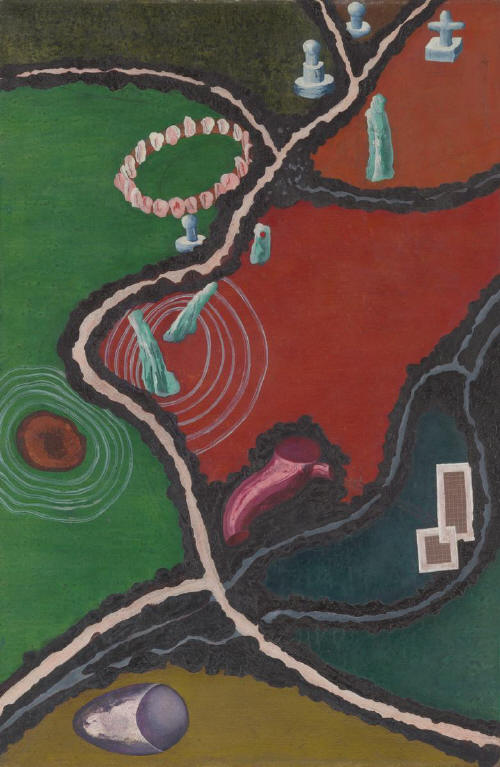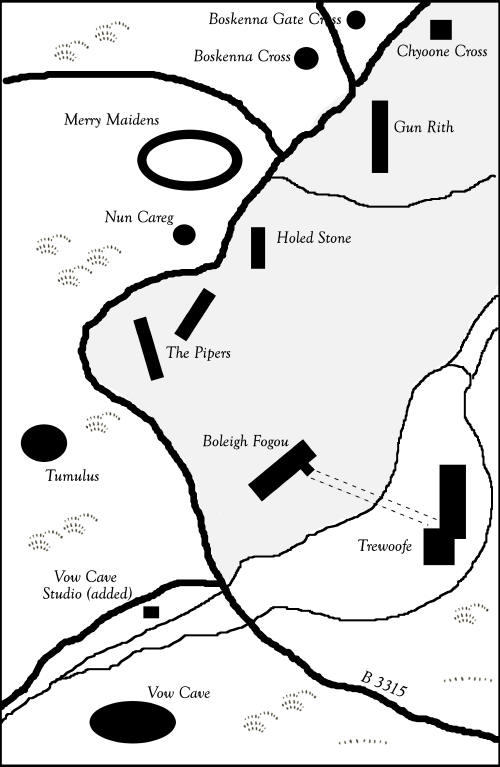|
|
| home | exhibitions | interviews | features | profiles | webprojects | archive |
|
A Key to Ithell Colquhoun's 'Landscape (with Antiquities)' Rupert White
Ithell Colquhoun is very much in the spotlight at the moment. As I write this, her retrospective at Tate St Ives, which has received many plaudits, has just transferred to Tate Britain. One of the many highlights of the show in St Ives was 'Landscape (with Antiquities)', an oil painting that for a long time was loaned by the National Trust to the Royal Cornwall Museum, but is now in the Tate collection. It is a bird's eye view of the landscape around Lamorna, near Penzance, which highlights the wealth of stone crosses and ancient monuments there. Landscape (with Antiquities) was painted in 1950, the year after Ithell acquired Vow Cave Studio in the Lamorna valley. It is easy to imagine that, on what would have been her first exploratory outings there, she took a sketch book with her and carefully noted details of all the stones. I say this because, though old OS maps are helpful, information and photographs were not as readily available as they are now, so she would have had to do her own field work, surveying and research.¹ Though superficially map-like the finished painting is, not surprisingly, more a map of the imagination. It has been twisted round so that the central road (the B3315), which in reality travels south west towards Land's End, appears to travel north. The antiquities are also slightly jammed in at the top and bottom of the painting. Despite this, they are, broadly speaking, in the right position relative to the roads, the stream, and each other and this makes it relatively easy to identify them.
There are three wheel-crosses in the painting. It is notable, though, that they all look smooth and strangely spherical, and on none of them is an inscribed cross visible. From top to bottom they are Boskenna Gate Cross, Boskenna Cross and Nûn Careg (meaning 'moorland rock'). As depicted by Colquhoun, Boskenna Cross has a distinctive tiered base, not unlike a wedding cake. The Latin-type cross in the top right corner of the painting is Chyoone (or Choone) Cross. As well as the 21-stoned Merry Maidens (Ithell has, for some reason, restored two stones), and a nearby holed stone which is now a gatepost, there are also three large standing stones. They are Gûn Rith (or 'The Fiddler') and the two 'Pipers'. In the painting both Pipers appear angled away from each other, though in reality one is completely upright. Gûn Rith, pronounced Goon Reeth and meaning 'Red downs', is visible from the stone circle and in alignment with it. Close to the road, a stones throw from Gûn Rith, is Tregiffian entrance grave. It is a significant feature of the ritual landscape here, but it was only excavated and exposed in the 1960s, hence why it doesn't appear in the painting. Features in the lower half of the image are a bit more obscure. The pink tongue-like form is definitely Boleigh fogou, however. The fogou is an ancient underground chamber in the garden of 'Rosemerryn', which Colquhoun describes at length in her book 'The Living Stones'. Its two entrances, one larger and one smaller, are clearly visible in the painting, so too its smaller side chamber, or 'creep', which branches off to the left of the main entrance. In The Living Stones Ithell describes the folklore associated with Boleigh fogou, mentioning 'it is believed that the passage once extended to the cellars of Trewoofe Mansion on the foundations of which the present farm stands' (p.39). This detail would explain the broken red lines extending to the right of the fogou, and would indicate that the two pale rectangles represent the historic manor of Trewoofe, itself the subject of many folktales. Trewoofe is depicted flanked by two dark blue-grey streams of water, the lower of which is a leat that fed the waterwheel at Clapper Mill. When referring to the Merry Maidens at Nûn Cerag (which she says means 'moorland rock'), Ithell adds 'they are at the centre of a Bronze Age cemetery' but, based on a dubious reading of William Hals' Parochial History, she claims that only one barrow remains 'on the brow of the hill between Rocky Lane and the road from Lamorna to Boleigh' (p.50). This corresponds to the non-descript brown circle to the left of the painting. It is also depicted on old OS maps, where it is simply marked 'tumuli'. In the chapter describing the fogou, Ithell notes that Boleigh means Place of Slaughter (p.40), and on old OS maps it is referred to as a 'Traditional site of a Battlefield AD 936'. This, it seems certain, explains why this large central section of the painting is coloured blood red. In the B&W map below I have shaded the red area light grey. Most believe that the purplish egg-shape is Vow Cave. This is not Ithell's studio of the same name, however, but the original Vow Cave which inspired the name. Vow Cave is a semi-natural feature on the top of Castallack Carn, that was visible from her studio, but isn't any longer. I believe the shape is a reference to the rock of the carn, and the cave itself appears as a kind of shadow beneath it. On the map below I have added Vow Cave Studio to show its relationship to Vow Cave.
1. The nearest equivalent to Colquhoun's painting appears in Naenia Cornubiensis by Copeland Borlase.
Refs: Norris, Katy (editor) (2025) Ithell Colqhoun: Between Worlds Tate Publishing Shillitoe, Richard (2010) Ithell Colquhoun: Magician Born of Nature. Thankyou to Richard for his comments and insights. Also see @ithellslivingstones on Instagram Page numbers apply to the first edition of 'The Living Stones' 2.6.25 |
|
|


